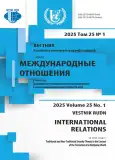Islamist Terrorist Activity in 2000-2020: A Scoring Methodology
- 作者: Chikrizova O.S.1
-
隶属关系:
- RUDN University
- 期: 卷 25, 编号 1 (2025): Traditional and Non-Traditional Security Threats in the Context of the Formation of a Multipolar World
- 页面: 30-44
- 栏目: THEMATIC DOSSIER
- URL: https://journal-vniispk.ru/2313-0660/article/view/320650
- DOI: https://doi.org/10.22363/2313-0660-2025-25-1-30-44
- EDN: https://elibrary.ru/JDJZPW
- ID: 320650
如何引用文章
详细
The relevance of the study of Islamist terrorism is due to its destructive impact on national and global security, as well as on the dialogue between Western and Eastern, particularly Muslim, nations since the early 2000s. Islamist terrorism reinforces entrenched prejudices against Islam and Muslims, leading to their demonization and the subsequent prevention of constructive interaction between communities professing different religions, thus hindering the establishment of relations based on mutual trust. This study examines the number of terrorist attacks committed by Islamist groups and their victims between 2000 and 2020, and tests the methodology for scoring their terrorist activities. Based on the Global Terrorism Database and the author’s sample of 155 groups broadcasting Islamist ideology, three stages of the development of Islamist terrorism were identified, a direct proportional relationship between the number of terrorist attacks and the number of victims was proven, and the geography of Islamist terrorist activity was analyzed. Methodologically, this study combines the analysis of terrorism as both a political phenomenon and a religious manifestation, and Islamist terrorist groups themselves are seen as political projects masquerading as religiously motivated communities. In contrast to the destabilization of Iraq, which along with Afghanistan became another platform for training terrorists, the terrorist attacks on September 11, 2001, had little impact on Islamist terrorism. Quantitative analysis revealed that the Middle East and North Africa was mistakenly perceived as the “epicenter” of Islamist terrorism in 2000-2020, as Southeast Asia was the leader in terrorist attacks in 2000, while South Asia occupied 1st place in 2003, 2005-2013, and 2018-2020. It has been confirmed that instability at the local and national levels serves as a fertile ground for Islamist terrorism. The possibilities and limitations of the proposed methodology are outlined, and the prospects for its further application in scientific studies of Islamist terrorism are described.
作者简介
Olga Chikrizova
RUDN University
编辑信件的主要联系方式.
Email: chikrizova-os@rudn.ru
ORCID iD: 0000-0002-1678-0967
SPIN 代码: 2963-7598
PhD (History), Associate Professor, Department of Theory and History of International Relations
Moscow, Russian Federation参考
- Bakhshi, U., & Rousselle, A. (2024). The history and evolution of the Islamic State in Southeast Asia. Current Trends in Islamist Ideology, 34, 5–26. Retrieved from https://s3.amazonaws.com/media.hudson.org/CT+34+final.pdf
- Carson, J. V., & Suppenbach, M. (2018). The Global jihadist movement: The most lethal ideology? Homicide Studies, 22(1), 8–44. https://doi.org/10.1177/1088767917733783
- Chikrizova, O. S. (2021). Shi’ite non-state armed actors in the Middle East: Iraqi case. Vestnik of Moscow State Linguistic University. Social Science, (1), 74–85. (In Russian). https://doi.org/10.52070/2500-347X_2021_1_842_74; EDN: VPSXXW
- Choukkar, M. (2024). The popular front of India and Muslim responses to Hindu nationalism. Current Trends in Islamist Ideology, 34, 59–83. Retrieved from https://s3.amazonaws.com/media.hudson.org/CT+34+final.pdf
- Davis, B. (2019). Violent extremist organizations: Past trends and short-term forecast. Journal of Strategic Security, 12(3), 37–156. https://doi.org/10.5038/1944-0472.12.3.1737
- Hamming, R. (2019). Global jihadism after the Syria war. Perspectives on Terrorism, 13 (3), 1–16.
- Harrow, M. (2010). The effect of the Iraq war on Islamist terrorism in the West. Cooperation and Conflict, 45(3), 274–293.
- Hegghammer, T. (2006). Global jihadism after the Iraq war. Middle East Journal, 60(1), 11–32.
- Hemmingsen, A.-S. (2013). Bliver Syrien En Skole for Terrorister? In C. B. Kjærsgaard & L. E. Andersen (Eds), Mellemøstens Nye Verden (pp. 28–42). København: Ræson Medier.
- Kosach, G. G. (2020). Hamas. National movement in a religious framework. Free Thought, (1), 79–92. (In Russian). EDN: JQRSTQ
- Morozov, V. M., & Khachirova, A. B. (2018). HAMAS and Hezbollah as actors: Comparative analysis and prospects of integration in the world order. Comparative Politics Russia, 9(2), 105–113. (In Russian). https://doi.org/10.18611/2221-3279-2018-9-2-105-113; EDN: XQRAGT
- Piazza, J. A. (2009). Is Islamist terrorism more dangerous? An empirical study of group ideology, organization, and goal structure. Terrorism and Political Violence, 21(1), 62–88. https://doi.org/10.1080/09546550802544698
- Piazza, J. A., & LaFree, G. (2019). Islamist terrorism, diaspora links and casualty rates. Perspectives on Terrorism, 13(5), 2–21.
- Pochta, Yu. M. (2021). Islamist terrorism in the context of contemporary hybrid wars. Vestnik RUDN. International Relations, 21(4), 734–746. (In Russian). https://doi.org/10.22363/2313-0660-2021-21-4-734-746; EDN: KXWIEL
- Ranjbar, D., & Chikrizova, O. S. (2023). Positive peace in the Islamic perspective of international relations: The case of Iran’s foreign policy. Vestnik RUDN. International Relations, 23(2), 278–295. https://doi.org/10.22363/2313-0660-2023-23-2-278-295; EDN: KMJXED
- Schmid, A. P. (Ed.). (2011. The Routledge handbook of terrorism research. London, New York: Routledge.
- Schmid, A. P., & Jongman, A. J. (1988). Political terrorism: A new guide to actors, authors, concepts, data bases, theories and literature. Amsterdam: Swidoc.
- Stepanova, E. A. (2014). ISIS and transnational Islamist terrorism. Pathways to Peace and Security, (2), 13–27. (In Russian). EDN: TEYLNN
- Stepanova, E. A. (2016). Long-term forecast of trends in terrorism. Pathways to Peace and Security, (1), 39–52. (In Russian). EDN: VXPUOV
- Stepanova, E. A. (2017). Russia and the United States in the fight against terrorism (comparative threats and approaches, Syria, Afghanistan, countering violent extremism). Pathways to Peace and Security, (1), 13–54. (In Russian). https://doi.org/10.20542/2307-1494-2017-1-13-54; EDN: ZBQDAJ
- Tan, A. T. H. (2024). Contemporary terrorism challenges and responses in the Indo-Pacific. Journal of Policing, Intelligence and Counter Terrorism, 19(3), 297–304. https://doi.org/10.1080/18335330.2024.2346474
- Yashlavskii, A. E. (2024). Islamist terrorism in Africa in the 2010–2020s: main trends and prospects. World Eсonomy and International Relations, 68(4), 66–76. (In Russian). https://doi.org/10.20542/0131-2227-2024-68-4-66-76 EDN: TIQNQC
补充文件









